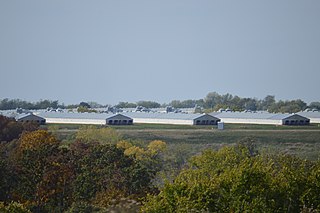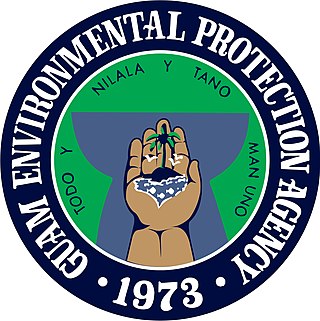Related Research Articles

Environmental laws are laws that protect the environment. Environmental law is the collection of laws, regulations, agreements and common law that governs how humans interact with their environment. This includes environmental regulations; laws governing management of natural resources, such as forests, minerals, or fisheries; and related topics such as environmental impact assessments. Environmental law is seen as the body of laws concerned with the protection of living things from the harm that human activity may immediately or eventually cause to them or their species, either directly or to the media and the habits on which they depend.

Pollution is the introduction of contaminants into the natural environment that cause adverse change. Pollution can take the form of any substance or energy. Pollutants, the components of pollution, can be either foreign substances/energies or naturally occurring contaminants.

Industrial waste is the waste produced by industrial activity which includes any material that is rendered useless during a manufacturing process such as that of factories, mills, and mining operations. Types of industrial waste include dirt and gravel, masonry and concrete, scrap metal, oil, solvents, chemicals, scrap lumber, even vegetable matter from restaurants. Industrial waste may be solid, semi-solid or liquid in form. It may be hazardous waste or non-hazardous waste. Industrial waste may pollute the nearby soil or adjacent water bodies, and can contaminate groundwater, lakes, streams, rivers or coastal waters. Industrial waste is often mixed into municipal waste, making accurate assessments difficult. An estimate for the US goes as high as 7.6 billion tons of industrial waste produced annually, as of 2017. Most countries have enacted legislation to deal with the problem of industrial waste, but strictness and compliance regimes vary. Enforcement is always an issue.

Environmental protection is the practice of protecting the natural environment by individuals, groups and governments. Its objectives are to conserve natural resources and the existing natural environment and, where it is possible, to repair damage and reverse trends.

In animal husbandry, a concentrated animal feeding operation, as defined by the United States Department of Agriculture (USDA), is an intensive animal feeding operation (AFO) in which over 1,000 animal units are confined for over 45 days a year. An animal unit is the equivalent of 1,000 pounds of "live" animal weight. A thousand animal units equates to 700 dairy cows, 1,000 meat cows, 2,500 pigs weighing more than 55 pounds (25 kg), 10,000 pigs weighing under 55 pounds, 10,000 sheep, 55,000 turkeys, 125,000 chickens, or 82,000 egg laying hens or pullets.

In environmental law, the polluter pays principle is enacted to make the party responsible for producing pollution responsible for paying for the damage done to the natural environment. This principle has also been used to put the costs of pollution prevention on the polluter. It is regarded as a regional custom because of the strong support it has received in most Organisation for Economic Co-operation and Development (OECD) and European Union countries, and has a strong scientific basis in economics. It is a fundamental principle in US environmental law.

Environmental planning is the process of facilitating decision making to carry out land development with the consideration given to the natural environment, social, political, economic and governance factors and provides a holistic framework to achieve sustainable outcomes. A major goal of environmental planning is to create sustainable communities, which aim to conserve and protect undeveloped land.

Environmental crime is an illegal act which directly harms the environment. These illegal activities involve the environment, wildlife, biodiversity and natural resources. International bodies such as, G7, Interpol, European Union, United Nations Environment Programme, United Nations Interregional Crime and Justice Research Institute, have recognised the following environmental crimes:

Reorganization Plan No. 3 was a United States presidential directive establishing the Environmental Protection Agency (EPA), effective December 2, 1970. The order, published in the Federal Register on October 6, 1970, consolidated components from different federal agencies to form the EPA, "a strong, independent agency" that would establish and enforce federal environmental protection laws.

Cherry Lake is part of historical coastal wetlands in Altona, a suburb of Melbourne, Victoria, Australia. The wetlands were converted to a lake with construction of retaining walls, levees and flow channels. The lake and surrounding reserve is an important wildlife habitat and popular recreational destination.
To protect the environment from the adverse effects of pollution, many nations worldwide have enacted legislation to regulate various types of pollution as well as to mitigate the adverse effects of pollution. At the local level, regulation usually is supervised by environmental agencies or the broader public health system. Different jurisdictions often have different levels regulation and policy choices about pollution. Historically, polluters will lobby governments in less economically developed areas or countries to maintain lax regulation in order to protect industrialisation at the cost of human and environmental health.

Water quality laws govern the protection of water resources for human health and the environment. Water quality laws are legal standards or requirements governing water quality, that is, the concentrations of water pollutants in some regulated volume of water. Such standards are generally expressed as levels of a specific water pollutants that are deemed acceptable in the water volume, and are generally designed relative to the water's intended use - whether for human consumption, industrial or domestic use, recreation, or as aquatic habitat. Additionally, these laws provide regulations on the alteration of the chemical, physical, radiological, and biological characteristics of water resources. Regulatory efforts may include identifying and categorizing water pollutants, dictating acceptable pollutant concentrations in water resources, and limiting pollutant discharges from effluent sources. Regulatory areas include sewage treatment and disposal, industrial and agricultural waste water management, and control of surface runoff from construction sites and urban environments. Water quality laws provides the foundation for regulations in water standards, monitoring, required inspections and permits, and enforcement. These laws may be modified to meet current needs and priorities.

The Environment Protection Authority Victoria (EPA) is Victoria’s environmental regulator. EPA is an independent statutory authority, established in 1971 under the Environment Protection Act 1970. EPA's role is to prevent and reduce the harmful effects of pollution and waste on Victorians and their environment.
The Ohio Environmental Protection Agency is the administrative department of the Ohio state government responsible for protecting the environment and public health by ensuring compliance with environmental laws. Those laws and related rules outline Ohio EPA's authority and what things the Agency can consider when making decisions about regulated activities.

The Guam Environmental Protection Agency is a government agency of the United States territory of Guam.

The Yarrowee River is a perennial river of the Corangamite catchment, located in the Central Highlands region of the Australian state of Victoria.
VicForests was a Government Backed Enterprise (GBE) operating in the Australian state of Victoria. Its principal function was to undertake logging and commercial sale of timber from state forests in Victoria.
The NSW Environment Protection Authority (EPA) is an independent statutory authority that sits in the Environment portfolio as part of the Planning and Environment cluster. It was established as an independent governing board in February 2012 separate from the Office of Environment & Heritage. The EPA is the state’s primary environmental regulator, working with businesses, government, community and environment groups to manage and reduce pollution, waste and adverse impacts on the environment.
Lemon Springs or Lemon Springs Bushland Reserve is a 1400-acre property situated 15km south of Kaniva, Victoria, Australia, in the municipality of West Wimmera Shire Council. It is known as the biggest toxic dumpsite found in Australia.
References
- ↑ Australian Government. Department of Climate Change, Energy, the Environment and Water. "What's protected under the EPBC Act".
{{cite web}}: CS1 maint: multiple names: authors list (link) - ↑ "Annex 1: Overview of the legislative framework and roles and responsibilities for Wildlife protection". www.vic.gov.au. 15 February 2022. Retrieved 2024-01-21.
- 1 2 3 Victoria, Environment Protection Authority. "Laws and regulations | Environment Protection Authority Victoria". www.epa.vic.gov.au. Retrieved 2024-01-18.
- ↑ "Unpacking the Biggest Change to Victoria's Environmental Regulation in 50 Years | Greencap". www.greencap.com.au. Retrieved 2024-01-21.
- ↑ Mannix, Liam (2018-06-21). "Individuals would get right to take polluters to court under new EPA laws". The Age. Retrieved 2024-01-21.
- 1 2 "Strengthening our waste and recycling system". www.vic.gov.au. 18 September 2023. Retrieved 2024-01-21.
- ↑ www.blakedigital.com, Blake Digital. "Amendments to the Flora and Fauna Guarantee Act Come Into Effect | Ecology and Heritage Partners". www.ehpartners.com.au. Retrieved 2024-01-21.
- ↑ Reserves, Forests and (2022-07-01). "Code of Practice for Timber Production 2014". Forests and Reserves. Retrieved 2024-01-21.
- ↑ Victoria's Department of Energy, Environment and Climate Action. (2 November 2023). "Water entitlements and the Water Act".
- ↑ catchments, Water and (2023-11-02). "Environmental entitlements". Water and catchments. Retrieved 2024-01-21.